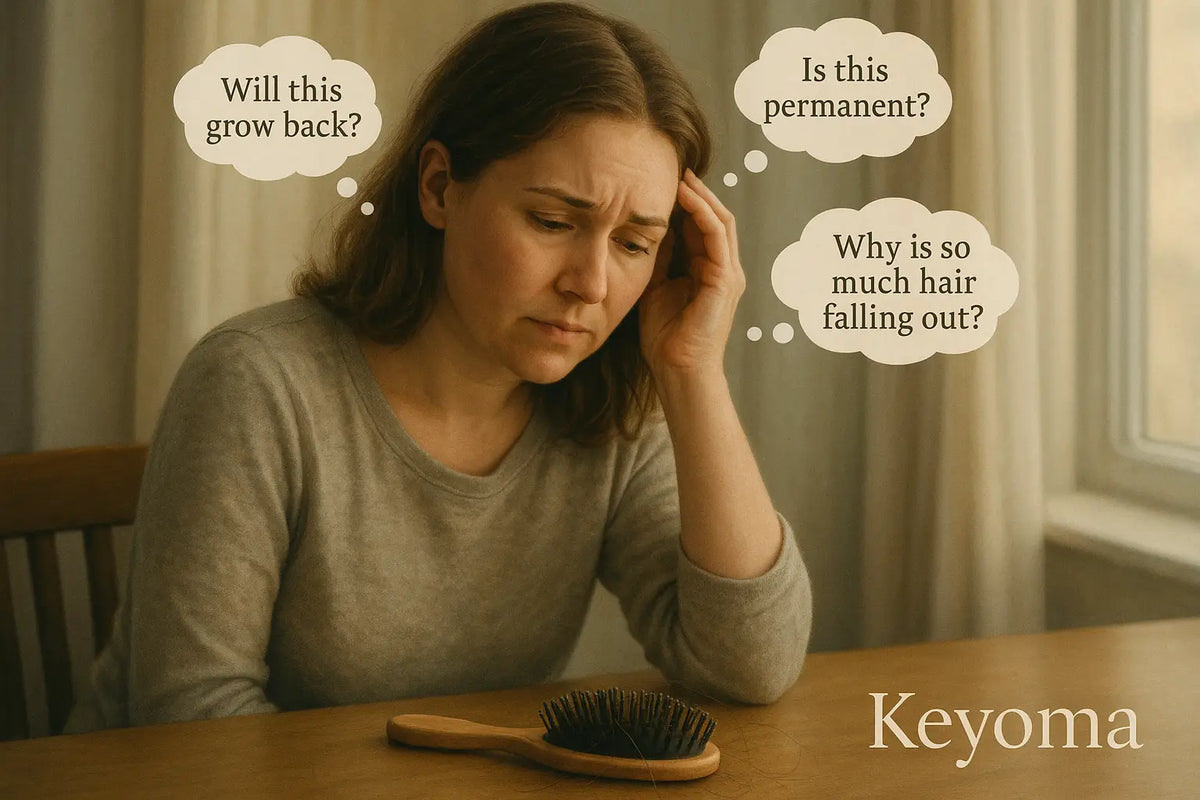In this article
Telogen effluvium happens when your body goes through a big change or a stressful period, causing noticeable hair shedding. Thinning often shows up near the crown, which can feel unsettling at first.
But in most cases, it does not last. Hair tends to grow back naturally within three to six months. While some treatments may help speed things up, your body usually knows how to recover on its own. It just needs time.
What Is Telogen Effluvium?
Telogen effluvium is a temporary type of hair shedding that usually follows physical stress or a major change in the body. To understand how it works, it helps to know the three main stages of hair growth:
-
Anagen (growth): This is the most active phase. Cells in the lower part of the follicle divide quickly, forming new hair that pushes older strands upward and extends the shaft. Each follicle can remain in this phase for up to four years. At any given time, about 80 to 90 percent of your hair is in the anagen stage.
-
Catagen (transition): This is a short, resting phase where the lower part of the follicle shrinks and growth stops. Only about 5 percent of your hair is in this stage at once.
-
Telogen (shedding): In this final phase, the follicle becomes inactive. The root develops a white keratin bulb—also called a club hair—which holds the strand in place until it naturally falls out and the next cycle begins. Around 5 percent of hairs are typically in this stage.
When a stressor hits, it can push as much as 70 percent of your growing hairs into the telogen phase all at once. That sudden shift causes noticeable thinning and shedding.
What Causes Telogen Effluvium?
On a healthy scalp, about 85 percent of hair follicles stay in the active growth stage (anagen). Around 15 percent rest in the shedding stage (telogen), and a small portion enters the short transitional stage (catagen).
Each follicle typically grows hair for four years, then rests for about four months. During that resting period, a new strand begins to form beneath the old one and eventually pushes it out.
Because of this natural cycle, losing up to 100 hairs a day is considered normal. You might notice them on your pillow, in your brush, or while showering.
But when your body goes through a sudden shock, that balance can shift. As many as 70 percent of actively growing hairs might move into the shedding phase all at once. This sudden change is what leads to visible hair thinning.
Common triggers include:
-
Childbirth: Postpartum shedding often starts a few months after delivery. It may resolve on its own or lead to female-pattern thinning.
-
Newborn hair loss: Temporary shedding seen in infants.
-
Illness: Sudden or ongoing conditions, especially with fever, can trigger hair loss.
-
Surgery: Hair shedding may follow a medical procedure.
-
Injury: Physical trauma can disrupt the hair cycle.
-
Emotional strain: High stress levels may cause follicles to shift into the shedding phase.
-
Rapid weight loss, extreme diets, or lack of nutrients (like low iron) can lead to thinning.
-
Medications: Certain drugs can cause temporary or prolonged hair shedding.
-
Hormonal issues: Conditions like underactive or overactive thyroid can affect growth.
-
Stopping birth control pills: Hormone shifts can lead to temporary hair loss.
-
International travel: Jet lag or time zone disruption may impact your hair cycle.
-
Scalp disorders: Skin conditions like erythroderma can damage follicles.
-
Too much sun: Excessive UV exposure can weaken or burn the scalp.
Telogen Effluvium Symptoms to Look For
Common signs of telogen effluvium include:
-
More shedding than usual. You might notice extra hair in your brush, the shower drain, or on your pillow.
-
Thinning that appears across the entire scalp.
-
Dry or brittle strands that fall out easily, even with light brushing.
Despite the shedding, your scalp should look normal. There should be no redness, itching, burning, flaking, or discomfort.
Telogen Effluvium vs Anagen Effluvium: What’s the Difference?
Anagen effluvium is a different type of hair loss. It often starts suddenly and leads to more dramatic shedding—sometimes in large clumps. The change can be quite jarring.
This kind of hair loss usually affects people undergoing cancer treatments or taking medications that interfere with cell growth, like alkylating agents or antimetabolites.
But there is some good news. Anagen effluvium, like telogen effluvium, is usually temporary. Hair often begins to grow back around six months after chemotherapy ends. The process can feel slow, but regrowth is possible.
Telogen Effluvium vs Androgenetic Alopecia: How They Differ
Androgenetic alopecia and telogen effluvium may appear alike early on, but they differ in several important ways. Watch for these signs to tell them apart:

Telogen Effluvium Is Temporary, Androgenetic Alopecia Is Not
Telogen effluvium leads to temporary hair shedding. Once the root cause is addressed, it often improves on its own. In most cases, the lost hair grows back without much intervention.
Androgenetic alopecia, on the other hand, is different. It causes long-term—often permanent—hair loss. While treatments might slow it down or help some hair regrow, it will not reverse itself naturally. Managing it usually requires consistent support.
So even though both conditions involve hair loss, the outcomes are very different. And the way you treat them should be, too.
Telogen Effluvium Affects All Over, the Androgenetic Alopecia Follows a Pattern
Telogen effluvium tends to cause general thinning all over the scalp. The hairline stays the same, but the overall volume decreases, making your hair look noticeably thinner.
With androgenetic alopecia, the pattern is different. You might notice your temples starting to recede or changes along your hairline. A bare spot near the crown is also common.
Because it is influenced by genetics, the exact pattern of androgenetic alopecia can vary from person to person.
Telogen Effluvium Starts Fast, the Androgenetic Alopecia Builds Slowly
Telogen effluvium usually starts suddenly. After a triggering event, hair enters a resting phase for a few months, then begins to shed heavily as the growth cycle resets.
Androgenetic alopecia works differently. It develops slowly, often taking years to become noticeable.
If you are dealing with androgenetic alopecia, you might spot gradual changes—like a receding hairline when you compare old photos to recent ones. You may also notice that your usual hairstyles no longer cover the front of your scalp the way they used to.
Telogen Effluvium Can Happen at Any Age, the Androgenetic Alopecia Happens With Age
Telogen effluvium can affect people at any age. It does not necessarily become more common as you get older.
It tends to show up more in women, possibly because of major hormonal changes, like those that happen after menopause. Women also seem more likely to seek treatment, which may affect how often the condition gets reported.
Androgenetic alopecia, on the other hand, can start at any age in men but becomes more noticeable—and often more severe—in middle-aged and older white males. By age 50, about half show signs of it. That number climbs to 80 percent by the time they reach 70.
Telogen Effluvium Treatment: What Helps Most

Managing telogen effluvium often begins with simple changes, like adjusting your lifestyle or using over-the-counter products.
The key is to figure out what triggered it—whether that is stress, hormonal changes, or everyday habits. Identifying the cause gives you a better chance at slowing the shedding and supporting regrowth.
Eat for Hair Strength
Your body might be missing important vitamins and minerals that support strong, healthy hair. It is a good idea to ask your doctor to check your levels—especially for iron, zinc, and vitamin D.
A balanced diet plays a big role in giving your body the nutrients it needs for proper hair growth.
Natural Oils to Support Growth
Natural oils help protect the scalp, seal in moisture, and boost overall hair health. Rosemary oil is especially popular for stimulating hair follicles and supporting growth.
Other oils—like coconut, argan, and jojoba—keep the hair hydrated and can reduce breakage over time.
Batana oil stands out for its rich blend of antioxidants and fatty acids. It helps repair damaged strands, adds thickness, and reduces shedding. Some of the key batana oil benefits also include strengthening weak roots and promoting steady regrowth in thinning spots.
Use Gentle Products and Routines
If you’re dealing with telogen effluvium, handle your hair with care while styling. Skip blow drying, flat ironing, or curling until shedding slows. Regular dyeing or bleaching can also weaken strands and slow regrowth during this period.
Explore Over-the-Counter Options
Over-the-counter treatments can also support regrowth. Choose a formula with 5 percent minoxidil. Apply it to your scalp once daily. It helps by extending the anagen phase—the active period when hair follicles produce new strands.
Manage Stress to Support Regrowth
If stress triggers your hair loss, lowering stress levels may support recovery. Try journaling or practicing mindfulness to ease tension. Yoga and other physical activities can calm your thoughts and provide a healthy outlet for emotional strain.
Support Telogen Effluvium Recovery With Keyoma’s Plant-Based Care
Managing telogen effluvium can be challenging since many factors—including illness, emotional stress, or hormonal shifts—can suddenly trigger it. Still, you can reduce risk by eating a nutrient-rich diet to avoid deficiencies, supporting your mental health, and seeking help when needed.
This type of hair shedding is usually temporary. While watching your hair thin can feel overwhelming, it often corrects itself in time.
If shedding continues or worsens, consult a healthcare provider to uncover the root cause. In prolonged cases, treatments like corticosteroids may be considered.
Start with natural support—Keyoma's pure Batana oil helps nourish your scalp and encourage regrowth gently and effectively.
Featured Product
100% Pure Batana Oil + Rosemary









